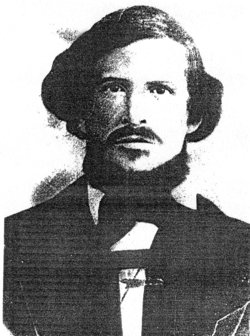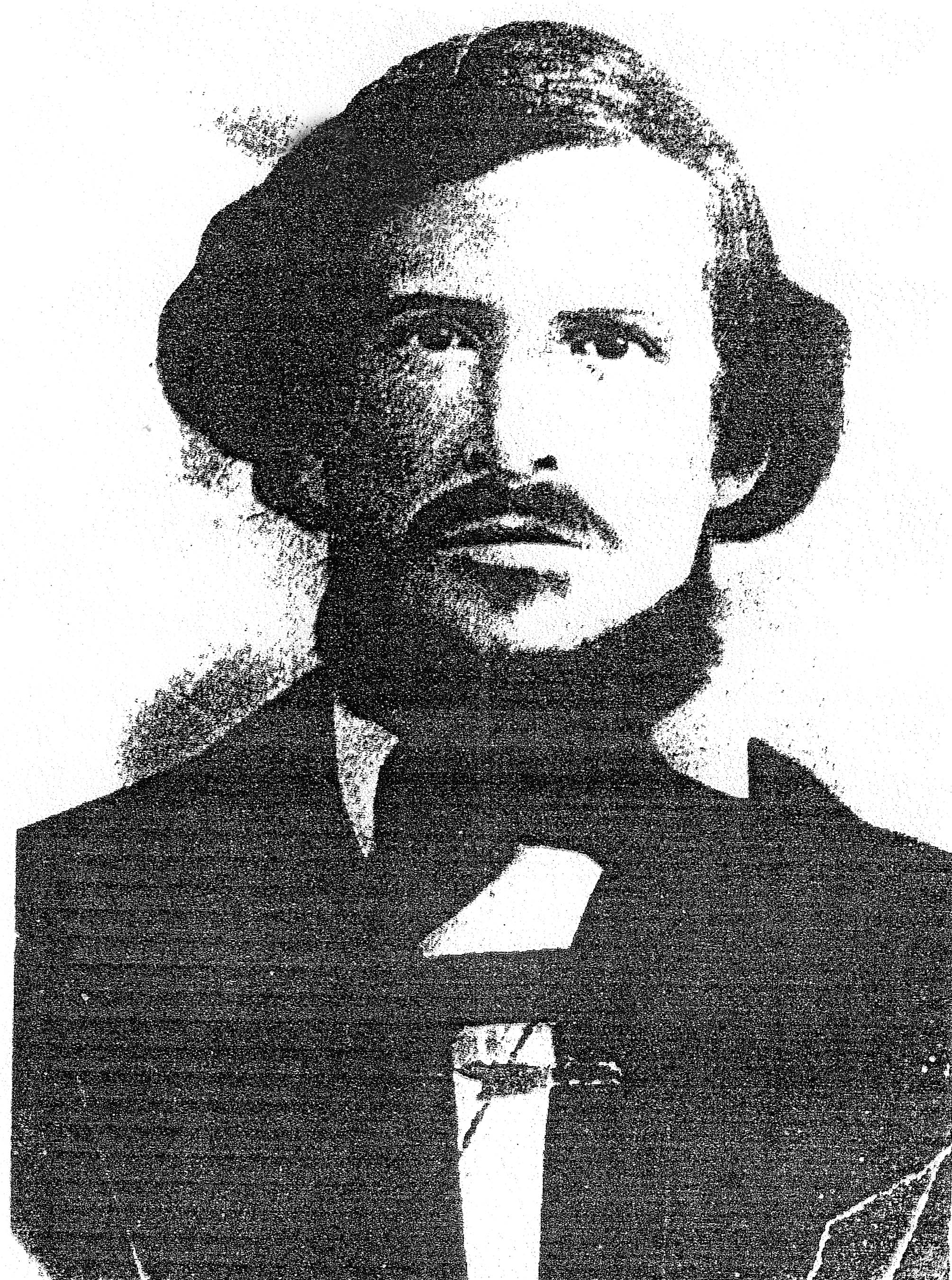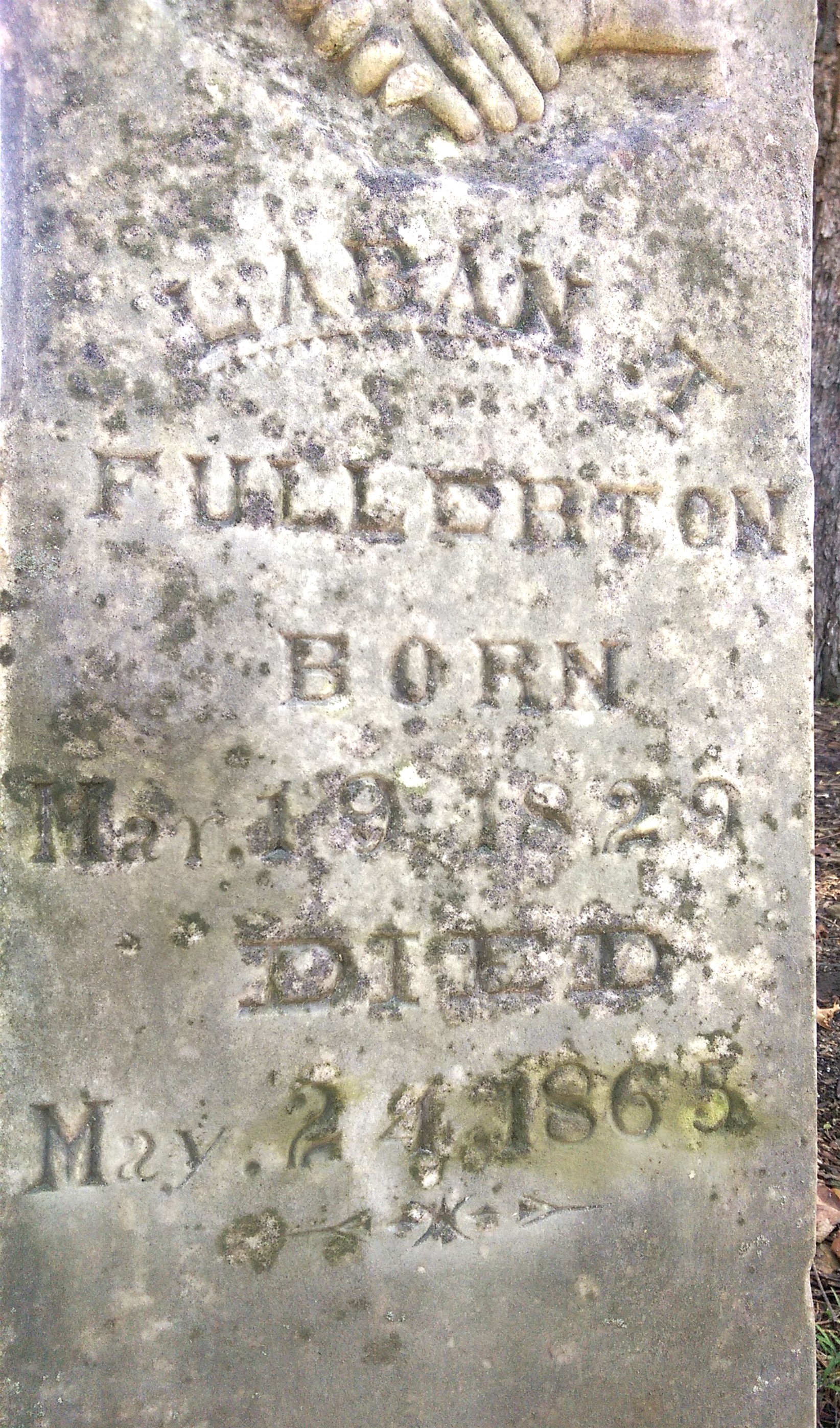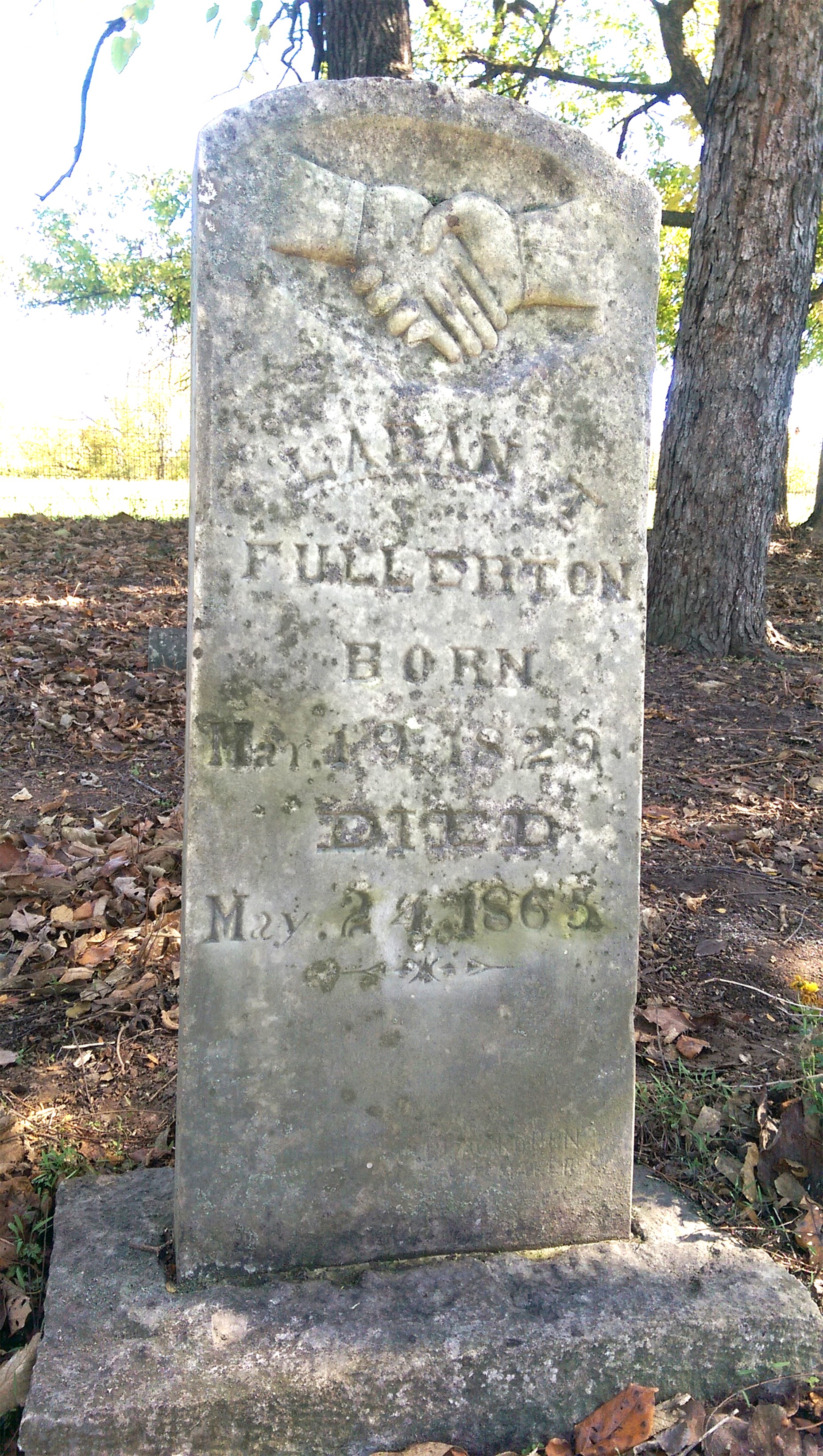Laban T. Fullerton, 31, a farmer
Those listed in the household are his wife, Mary M Fullerton 28 and known children:
Sarah E Fullerton 13
Mary C Fullerton 8
Vernetta Fullerton 6
John L Fullerton 3
James Fullerton 4/12
also at the end of list was Zerilda Fullerton, age 17. It is not known whether she is a child or other family member.
Update note: 19 Nov 2015
Zerilda was Laban's younger sister
info provided by Seeker (Laban's great grandson via John L., then Oren E.)
The article below was copied with permission from an article written by Helen Fullerton Hunter that was printed in the Relevant Past, a Quarterly Newsletter of the Jasper County Records Research Center in Carthage, Missouri.
THE FULLERTON TRAGEDY
The tragic history in one man's family started in 1865. This is the story of the Laban Taylor Fullerton family.
Laban was the son of John McCune Fullerton and Ann Nancy (Rawls) [Fort] Fullerton, who settled in Sarcoxie in 1834.
Laban married Margaret Potts in August 8, 1846 in Jasper county. The couple settled on the Lawrence/Jasper county line, just east of Sarcoxie. The Laban Fullerton Cemetery is located in a field on this same site. Laban was shot in February, 1865, while giving chase to southern sympathizers returning to the county after the Civil War. He later died of his wounds in May of that year. He was 36 years old and the last civilian casualty of that war in this area.
Further tragedy followed with the strange but true story of his widow, Mary Margaret. She is described in the 1868 newspaper, Fountain, as "medium size and height, dark hair and eyes, full forehead and good countenance and character." She had seven children, one was sixteen years old name Mary C.
The story starts early in 1868 when a man of "prepossessing appearance" came into the Sarcoxie neighborhood in Dec. 1867. He claimed his name was George Hutton. With him came his alleged half-brother, who gave his name as Tommy Turley. Turley appeared to be a youth of 15 to 16 years of age. After a time and getting in good graces with the Fullerton family. Hutton convinced Mrs. Fullerton to let him marry her daughter, Mary C. The couple lived with Mrs. Fullerton while Tommy Turley did work on the farm. It was reported that Mrs. Fullerton had sold some of her land about this time for $5000 and had the cash with her. It was then that Tommy Turley and George Hutton began a campaign to get Mrs. Fullerton to go with or take them part of they way to Ohio were she was told that Tommy's father, Col. Turley would award her handsomely for her help. They would drop her off at Sedalia so she could visit relatives living living there. Apparently, her daughter, Mary , also tried to persuade her to go. After months of constant pressure Mrs. Fullerton agreed to go if she could seek advice from a trusted friend and neighbor. She failed to do so but did seek advice from a W. A. Hagar on Feb 17, 1868 and was advised by Hager not to go to Ohio.
Even after this advise, in the later part of Feb. 1868, they (Hutton, Fullerton, Turley) started in a wagon going in a northward direction with Tommy Turley laying in the back of the wagon. Hutton and Turley returned after a seventeen day absence without Mr. Fullerton. Hutton stated that they left Mrs. Fullerton in Sedalia. He also told the story that she went to St. Louis and married a grocer by the name of Enslow. It was later learned that Hutton and Turley had indeed gone to Sedalia and had forged papers with Mrs. Fullerton's signature authorizing the sale of her livestock and property.
After returning to Sarcoxie, Hutton had began selling off Fullerton livestock and property. One of the Fullerton who was about 10 years old at the time told how Hutton would have him ride the horses long and hard each day. This was probably what brought about the suspicion of Hutton and the forming of a posse to escort Hutton to Sarcoxie for questioning. They found him with the Fullerton children in a wagon loaded with belongings headed to parts unknown. As the posse neared Hutton and demanded his surrender, he whipped his horses and a running fight ensued. In the process of trying to capture Hutton, shots were fired. Hutton was injured in the shoulder and hip as well as a bullet passed through Mary C's coat and wounded one of the children named Alice. The posse forced Hutton to pull into the Round Prairie schoolyard and he was captured in the northwest corner of that yard. He was then taken to Doctor Wilson's office on the northwest corner of the Sarcoxie square for treatment. The doctor removed Hutton's clothing in order to treat his wounds.
Three or four days after that, between 3 and 4 AM in the morning, a party of unknowns broke in and took the undressed Hutton, wrapped in bed linens, two miles east of Round Prairie School and hung him. It was said that Hutton offered no resistance and it was believed the party that hung him were his friends.
In April of 1868, Tommy Turley was located in St. Louis by local Sarcoxie attorney, Gilbert Schooling. He was dressed like a woman and living under the alias of Mrs. Fullerton. Schooling persuaded him to come back to Sarcoxie for questioning. If it wasn't for Schooling's detective work locating Turley, we would not have the information we have on this mystery.
It turns out that Tommy Turley was really Mary Springer and George Hutton's wife. At the time of her arrest, she was described as handsome woman, medium size, auburn hair tending to curl, large gray eyes, an expression of sorrow marked her face. She could converse at times and then would sink into deep silence that could be described as depression. She was raised as an orphan and was a graduate of Oxford College, Ohio.
Her story was that she met Hutton in Ohio where he deceived her and married her. He had different odd jobs on their way from Ohio, to St. Joseph, MO. and then to Baxter Springs, KS. He did farm some but would disappear for long periods at a time. That year Mary gave birth to a child. Hutton not providing her with enough food to give sufficient nutriment to herself and the child, she fell ill and her child died of starvation. The neighbors buried the child and report that Hutton appeared indifferent to both the condition of his wife and the death of his child. She stated she did make an attempt to leave him but he forced her to stay with him telling her she was too sick to work. He told her to disguise herself as a boy and she would drive one of his two teams to Granby, MO.
Upon reaching Granby, Mary was so ill she could no longer drive the team but lay in their tent sick. Hutton did little or no work and would again disappear for periods at a time. They soon moved into Mrs. Fullerton's neighborhood. I think in today's world she would be described a victim of domestic abuse. That being said, it doesn't excuse her part in this whole affair.
I will pick up the story Springer told of what happened when she and Hutton started on the trip with Mrs. Fullerton.
After the three started off in the wagon that winter morning, she was lying sick in the wagon bed and did not notice the road. . . about 6PM she complained of a severe headache. Hutton stopped the wagon and made her some coffee, which she drank and did not know what happened after that until 6 or 7AM the next day. She noticed Mrs. Fullerton was missing and when asked, Hutton told her to mind her own business, do what she was told if she ever wanted any more money from him. They proceeded to make their way to Sedalia and began forging papers before returning to Sarcoxie. Although Springer said she did not know what happened to Mrs. Fullerton, she testified that she told Hutton not to go through with his plan and that she could show where Mrs. Fullerton was killed. Also, when she and Hutton returned to Sarcoxie, she was wearing clothes that Mrs. Fullerton had taken on her trip.
May of 1868, Springer was brought before Judge Price and the charges against her were dismissed. The reasons given by her attorney was there was no body so no proof that Mrs. Fullerton was murdered. After her release, there was a near riot on the Carthage square. The Carthage Banner reported, "At a meeting of Carthage citizens (on the square) and presided over by Frank Garrison, formal protest was made against the activities of armed vigilance committees in searching for the Turley woman after she had been acquitted, the resolutions urging that steps taken should be of a legal nature and asserting that the action of the vigilance committees was 'doing our town and county great damage by reason of magnified reports reaching the ears of persons living away from our midst'. Great sympathy was declared for Mrs. Fullerton's family and it was said we will do all in our power to assist them in bring her murderers to justice.". . . ."The body of Mrs. Fullerton was never found, but there was never any doubt int he minds of her relatives that she was murdered. It is also believed that the children would have shared the same fate had not Hutton been captured and hanged."
There are several unanswered questions concerning this case:
Why did the hanging party hang George Hutton before he could tell them the fate of Mrs. Fullerton?
How did Tommy Turley/Mary Springer disappear after they captured George Hutton?
There is no record of Mary Springer showing investigators the location where George Hutton stopped and made coffee. Why?
What happened tot he reported $5000 Mrs. Fullerton received for the sale of her land? It was never located.
W. A. Hagar was married to Sarah Fullerton and after the tragedy, the 1870 Census reported that Hagar and his wife Sarah have 3 of the Fullerton children residing with them; Mary C. age 16; Robert T. age 9; and Margaret A. age 7.
Laban T. Fullerton, 31, a farmer
Those listed in the household are his wife, Mary M Fullerton 28 and known children:
Sarah E Fullerton 13
Mary C Fullerton 8
Vernetta Fullerton 6
John L Fullerton 3
James Fullerton 4/12
also at the end of list was Zerilda Fullerton, age 17. It is not known whether she is a child or other family member.
Update note: 19 Nov 2015
Zerilda was Laban's younger sister
info provided by Seeker (Laban's great grandson via John L., then Oren E.)
The article below was copied with permission from an article written by Helen Fullerton Hunter that was printed in the Relevant Past, a Quarterly Newsletter of the Jasper County Records Research Center in Carthage, Missouri.
THE FULLERTON TRAGEDY
The tragic history in one man's family started in 1865. This is the story of the Laban Taylor Fullerton family.
Laban was the son of John McCune Fullerton and Ann Nancy (Rawls) [Fort] Fullerton, who settled in Sarcoxie in 1834.
Laban married Margaret Potts in August 8, 1846 in Jasper county. The couple settled on the Lawrence/Jasper county line, just east of Sarcoxie. The Laban Fullerton Cemetery is located in a field on this same site. Laban was shot in February, 1865, while giving chase to southern sympathizers returning to the county after the Civil War. He later died of his wounds in May of that year. He was 36 years old and the last civilian casualty of that war in this area.
Further tragedy followed with the strange but true story of his widow, Mary Margaret. She is described in the 1868 newspaper, Fountain, as "medium size and height, dark hair and eyes, full forehead and good countenance and character." She had seven children, one was sixteen years old name Mary C.
The story starts early in 1868 when a man of "prepossessing appearance" came into the Sarcoxie neighborhood in Dec. 1867. He claimed his name was George Hutton. With him came his alleged half-brother, who gave his name as Tommy Turley. Turley appeared to be a youth of 15 to 16 years of age. After a time and getting in good graces with the Fullerton family. Hutton convinced Mrs. Fullerton to let him marry her daughter, Mary C. The couple lived with Mrs. Fullerton while Tommy Turley did work on the farm. It was reported that Mrs. Fullerton had sold some of her land about this time for $5000 and had the cash with her. It was then that Tommy Turley and George Hutton began a campaign to get Mrs. Fullerton to go with or take them part of they way to Ohio were she was told that Tommy's father, Col. Turley would award her handsomely for her help. They would drop her off at Sedalia so she could visit relatives living living there. Apparently, her daughter, Mary , also tried to persuade her to go. After months of constant pressure Mrs. Fullerton agreed to go if she could seek advice from a trusted friend and neighbor. She failed to do so but did seek advice from a W. A. Hagar on Feb 17, 1868 and was advised by Hager not to go to Ohio.
Even after this advise, in the later part of Feb. 1868, they (Hutton, Fullerton, Turley) started in a wagon going in a northward direction with Tommy Turley laying in the back of the wagon. Hutton and Turley returned after a seventeen day absence without Mr. Fullerton. Hutton stated that they left Mrs. Fullerton in Sedalia. He also told the story that she went to St. Louis and married a grocer by the name of Enslow. It was later learned that Hutton and Turley had indeed gone to Sedalia and had forged papers with Mrs. Fullerton's signature authorizing the sale of her livestock and property.
After returning to Sarcoxie, Hutton had began selling off Fullerton livestock and property. One of the Fullerton who was about 10 years old at the time told how Hutton would have him ride the horses long and hard each day. This was probably what brought about the suspicion of Hutton and the forming of a posse to escort Hutton to Sarcoxie for questioning. They found him with the Fullerton children in a wagon loaded with belongings headed to parts unknown. As the posse neared Hutton and demanded his surrender, he whipped his horses and a running fight ensued. In the process of trying to capture Hutton, shots were fired. Hutton was injured in the shoulder and hip as well as a bullet passed through Mary C's coat and wounded one of the children named Alice. The posse forced Hutton to pull into the Round Prairie schoolyard and he was captured in the northwest corner of that yard. He was then taken to Doctor Wilson's office on the northwest corner of the Sarcoxie square for treatment. The doctor removed Hutton's clothing in order to treat his wounds.
Three or four days after that, between 3 and 4 AM in the morning, a party of unknowns broke in and took the undressed Hutton, wrapped in bed linens, two miles east of Round Prairie School and hung him. It was said that Hutton offered no resistance and it was believed the party that hung him were his friends.
In April of 1868, Tommy Turley was located in St. Louis by local Sarcoxie attorney, Gilbert Schooling. He was dressed like a woman and living under the alias of Mrs. Fullerton. Schooling persuaded him to come back to Sarcoxie for questioning. If it wasn't for Schooling's detective work locating Turley, we would not have the information we have on this mystery.
It turns out that Tommy Turley was really Mary Springer and George Hutton's wife. At the time of her arrest, she was described as handsome woman, medium size, auburn hair tending to curl, large gray eyes, an expression of sorrow marked her face. She could converse at times and then would sink into deep silence that could be described as depression. She was raised as an orphan and was a graduate of Oxford College, Ohio.
Her story was that she met Hutton in Ohio where he deceived her and married her. He had different odd jobs on their way from Ohio, to St. Joseph, MO. and then to Baxter Springs, KS. He did farm some but would disappear for long periods at a time. That year Mary gave birth to a child. Hutton not providing her with enough food to give sufficient nutriment to herself and the child, she fell ill and her child died of starvation. The neighbors buried the child and report that Hutton appeared indifferent to both the condition of his wife and the death of his child. She stated she did make an attempt to leave him but he forced her to stay with him telling her she was too sick to work. He told her to disguise herself as a boy and she would drive one of his two teams to Granby, MO.
Upon reaching Granby, Mary was so ill she could no longer drive the team but lay in their tent sick. Hutton did little or no work and would again disappear for periods at a time. They soon moved into Mrs. Fullerton's neighborhood. I think in today's world she would be described a victim of domestic abuse. That being said, it doesn't excuse her part in this whole affair.
I will pick up the story Springer told of what happened when she and Hutton started on the trip with Mrs. Fullerton.
After the three started off in the wagon that winter morning, she was lying sick in the wagon bed and did not notice the road. . . about 6PM she complained of a severe headache. Hutton stopped the wagon and made her some coffee, which she drank and did not know what happened after that until 6 or 7AM the next day. She noticed Mrs. Fullerton was missing and when asked, Hutton told her to mind her own business, do what she was told if she ever wanted any more money from him. They proceeded to make their way to Sedalia and began forging papers before returning to Sarcoxie. Although Springer said she did not know what happened to Mrs. Fullerton, she testified that she told Hutton not to go through with his plan and that she could show where Mrs. Fullerton was killed. Also, when she and Hutton returned to Sarcoxie, she was wearing clothes that Mrs. Fullerton had taken on her trip.
May of 1868, Springer was brought before Judge Price and the charges against her were dismissed. The reasons given by her attorney was there was no body so no proof that Mrs. Fullerton was murdered. After her release, there was a near riot on the Carthage square. The Carthage Banner reported, "At a meeting of Carthage citizens (on the square) and presided over by Frank Garrison, formal protest was made against the activities of armed vigilance committees in searching for the Turley woman after she had been acquitted, the resolutions urging that steps taken should be of a legal nature and asserting that the action of the vigilance committees was 'doing our town and county great damage by reason of magnified reports reaching the ears of persons living away from our midst'. Great sympathy was declared for Mrs. Fullerton's family and it was said we will do all in our power to assist them in bring her murderers to justice.". . . ."The body of Mrs. Fullerton was never found, but there was never any doubt int he minds of her relatives that she was murdered. It is also believed that the children would have shared the same fate had not Hutton been captured and hanged."
There are several unanswered questions concerning this case:
Why did the hanging party hang George Hutton before he could tell them the fate of Mrs. Fullerton?
How did Tommy Turley/Mary Springer disappear after they captured George Hutton?
There is no record of Mary Springer showing investigators the location where George Hutton stopped and made coffee. Why?
What happened tot he reported $5000 Mrs. Fullerton received for the sale of her land? It was never located.
W. A. Hagar was married to Sarah Fullerton and after the tragedy, the 1870 Census reported that Hagar and his wife Sarah have 3 of the Fullerton children residing with them; Mary C. age 16; Robert T. age 9; and Margaret A. age 7.
Family Members
Advertisement
Advertisement






















